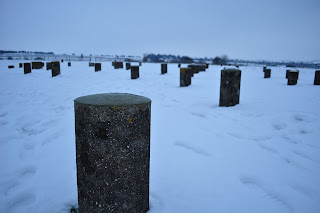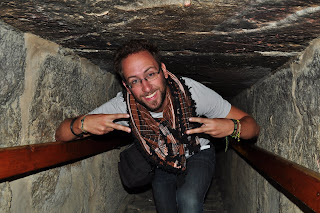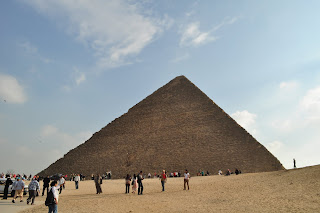Dec. 21st-23rd
As happy as I was to leave the blood-pressure raising abyss known as Hurghada, I was equally as scared to delve back into western society. I had spent nearly seven months on the African continent, and was constantly introduced to new and interesting customs and cultures. Now, to be reacquainted with the conventions and habits of my former life, I was definitely anxious. It also didn't help that I was landing in one of Europe's largest and arguably most fashionable metropolises (London), wearing tight women's jeans I had bought in Kenya and a form-fitting woman's winter-jacket I had found at a flea-market in Cairo.
On my flight I had found out that London had suffered a 'terrible' snowstorm and that not only were hundreds of flights cancelled, both arriving and departing London's major airports, but due to all the stranded passengers, all hotel rooms were booked in the entire city. Luckily for myself, Erik, or birdman as he is affectionately known, was studying in London and offered to let me stay at his empty flat while he was visiting his family in Germany over the holidays.

My plane landed at Gatwick and I took the train into the heart of London. The shock of the snowstorm hit me, not the storm itself, but rather the lack thereof: I could still see as much green as snow-cover. Pardon my Canadian snow-snobbery, but I felt like these jolly old Brits were kind of catastrophizing.
I then took a ridiculously-expensive-if-you-compare-it-to-almost-anything-I-did-in-Africa-cab-ride, and made my way to Erik's flat. Not only did he go to school at the London School of Economics, which is located on Drury lane (insert muffin-man joke here), in the heart of London, but he left me a note that would profoundly change my stay in this city. He was one of the poor travelers trying to reach their families over the holidays, only to have their flights repeatedly cancelled due to London's flat-footed response to the snow. As a result, Birdman and Moleman would be reunited once more!

The nice lady at the front desk gave me the key to Erik's flat and I settled into my first comfortable night's sleep in several days. Before doing so, I took the hottest, non-salty shower I had taken since Ethiopia.
Bliss. Pure bliss.
The following morning, I woke up early out of habit and eagerly awaited the arrival of Erik. When he showed up, it was if we had picked up where we had left off in Jinja, Uganda. We went out for a hearty English breakfast, caught up as much as we could in the limited time we had, and proceeded to walk around the beautiful city of London.

We passed many famous landmarks like the British Parliament (Palace of Westminster) and Big Ben; Westminster Abbey, the London Eye and Trafalgar Square. Since Erik lived in the city and I had already toured the inside of these awesome architectural edifices on another trip, we just took the time to reminisce about our month-long voyage together around Lake Victoria, taking in the ambiance which is London town.

We capped our evening with a delicious curry dinner with Erik's ladybird, Sabrina.

I had considered the idea that I would try to visit Stonehenge as the final monument on my more than monumental trip, but the price and time consumption in getting there made it seem like somewhat of a daunting task. Erik, who had unfortunately found out that his flight would yet again be cancelled, suggested that he should accompany me and that we should rent a car.

We looked into prices and within the hour we were in a Volkswagen Golf, on our way to Stonehenge. Coming from the immense country of Canada, it was quite ridiculous to see how small and close everything was in England. Using the GPS feature on Erik's Blackberry, we found Stonehenge pretty easily: the fact that it was literally right beside the highway made it an even easier task.

Braving the bitter English winter, we walked around the ancient pillars dating from 2400-2200BC; well, all 10 meters of which wasn't cordoned off, and attempted to listen to the audio-guide which was included with our entrance. A vast majority of the site was blocked off once again due to the snowstorm which rendered the ground soft and 'dangerous', so we took some pictures and returned to the warmth of the gift-shop.

While looking at Erik's Blackberry, we noticed that another ancient monument was not far away and decided to venture to England's most impressive, yet little known prehistoric shrine: Woodhenge!

We parked the car and were surprised to see that there was no admission and that we didn't have to push through throngs of people to see it. Woodhenge, which dates from around 2300BC, is another Neolithic monument belonging to the Stonehenge UNESCO World Heritage site, but unlike its stony brother, woodhenge does not even have any remaining lumbar to speak of. Instead, all the original timber posts have been replaced by stubby stone cylinders. We took turns standing on the various pseudo-trunks, while Erik screamed WOODHENGE at the top of his lungs. Good times.

From there, we drove to our final destination in the English countryside, and the terminus of my 7-month adventure: Salisbury. Salisbury is a beautiful medieval town founded in 1220 and is centered around its spectacular cathedral, whose spire, rising 123m (404 ft), is still the tallest in all of the UK. The Salisbury cathedral also boasts the UK's oldest surviving mechanical clock from 1386.

We had arrived at the Cathedral in the evening, and to gaze upon it in the moonlight was surprisingly beautiful. The fact that it was only 3 days away from Christmas added to allure of this holy building. Despite the winter chill, I was filled with an unspeakable warmth that made it impossible to stifle a smile.

For the first time in my life I was not sad to end a trip. I'm passionately against calling this journey a vacation. I would rather deem it a pilgrimage. A pilgrimage of potential if you will.

My journey ended up being far more personal and spiritual than I ever could have fathomed. Upon completing it, I achieved a happiness I didn't even know was possible, along with a newfound respect for myself and my capabilities.

As I walked through this beautiful Cathedral, with its holy relics and stunning architecture, the last 7 months of my life flooded my thoughts. In the center of church was a perfectly tranquil pool of water, still to the point of mirror-like reflection. How fitting and metaphorical to the sentiments I was feeling and my state of contemplation.

Erik and I soon left this place of worship and drove back to London. We spent my final evening chatting over pints and English pub fare.
The morning of my departure, Erik met up with me before I boarded the Underground. We hugged and I shed a few tears. Not out of sadness, but out of joy to have met such an amazing friend, and to have experienced all I had on my African adventure. My trip ended as it had began, hugging someone I care deeply for, and not knowing what lies ahead.
Alpha meets Omega.
Life is a journey, with its ups and downs and unexpected challenges; its unrivaled dynamism and humbling accomplishments. I am beyond fortunate to have lived what I have shared with you all for the past year and a half.
As I stated before, life is a journey, but I am so blessed that this journey was my life.
Fin
(At least for now!)











































